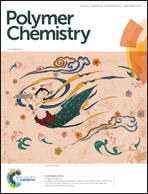Synthesis and chiroptical properties of helical polystyrenes stabilized by intramolecular hydrogen bonding†
Abstract
Two novel enantiopure styrene derivatives (L- and D-1) bearing the chiral amide groups were designed and synthesized. The polymerization of these monomers using the reversible addition fragment transfer (RAFT) radical polymerization afforded a series of poly-L-1ms and poly-D-1ms in high yields with controlled molecular weights (Mns) and narrow molecular weight distributions (Mw/Mns). Interestingly, these polymers could adopt a stable helical conformation when the degree of the polymerization reached ca. 60 owing to the intramolecular hydrogen bonding between the adjacent repeating units as revealed by circular dichroism (CD) spectroscopy, UV-vis spectroscopy, and polarimetry. The helicity of these polymers could be tuned via solvent and temperature alterations. Increasing the temperature or the polarity of the solvents weakens the intramolecular hydrogen bonding, and thus the helical structure may transform to a random coil, endowing these polymers with multi-responsiveness. Moreover, such helical polymers could be further copolymerized with a cross linker, leading to the formation of a core cross-linked star polymer carrying the helical arms. Because of the chirality of the helical arms, the star polymer showed an excellent ability in enantioselective crystallization using racemic D/L-threonine as the model compounds. The enantiomeric excess (ee) of the induced crystals was up to 95%.



 Please wait while we load your content...
Please wait while we load your content...